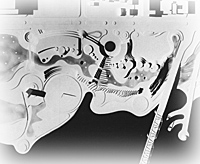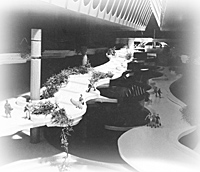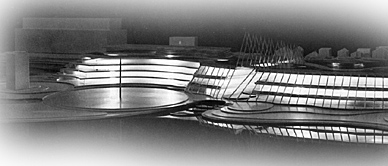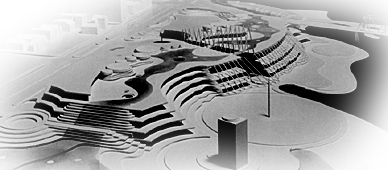FULL TOUR
The
Architect - CARDINAL'S DESIGN VISION
The project to build CMC brought
Cardinal squarely into the national architectural arena. His
understanding of his task was embodied in the opening paragraph
of his conceptual design proposal:
"Symbols are the way we communicate. Words and sounds are
symbols and writings are symbols of words and sounds. Pictures
are symbols of feelings, events, and can communicate impressions
beyond words in two dimensions. Sculpture goes beyond pictures
to symbolize impressions. Architecture, perceived as living
sculpture, symbolizes even more the goals and aspirations of our
culture. My challenge is to evoke images, creating images in
sculptural and architectural forms that symbolize the goals
and aspirations of this National Museum."
He understood too that Canada's history and culture have been
shaped by geography. The museum building had to represent this
fact by appearing to be an integral part of its site, growing
out of the landscape, moving and flowing with the contours of
the land like a massive outcropping of stratified rock. Looking
back in 1984, he declared:
"Within this great continent, wherein lies this expansive
and diverse nation, I could sense the feeling of time, the
rhythm of time and the way nature had shaped and formed the
land - that the formations had been carved by the elements
and forces of nature, by wind, rain, the movement of water, the
warmth of day, the coolness of night, the seasons. I felt that
the building itself should express the evolution of the natural
formations."
Initial design concept proposed by Douglas
Cardinal. Birds-eye view: the building "flows with the
contours of the land like a massive natural outcropping of
stratified, native rock".
© Douglas J. Cardinal Architect Ltd.
|

|
He felt that a building in harmony with the land would be in
keeping with the cultures of Canada's native peoples, and
therefore thought in terms of the simple lines and forms that
make up the artistic designs of those peoples, seeking to
capture their grace and beauty of movement.
Initial design concept proposed by Douglas
Cardinal. Early thinking about the Grand Hall is seen here; much
of the concept survived, but with the series of waterfalls moved
to the outside of the hall.
© Douglas J. Cardinal Architect Ltd.
|

|
If the building was to symbolize the land, it also had to permit
the embodiment and presentation of the many cultures that have
created Canada, to capture the spirit of the country and of its
people, and to serve as a cultural bridge. Not only the
remembrance of the past, but the dynamism of the present, and
confidence in the future needed to find expression in the new
museum; CMC may have its roots in the past, but it really
addresses the present, by showing that past cultures live and
evolve in present-day Canada.
Although his original mandate did not extend beyond design of
the building's structure, he anticipated the unfolding
conceptual designs for the interior facilities, exhibits,
programmes, and indeed the mission of the museum, in his belief
that artifacts should be displayed in dramatic settings
reminiscent of the past. He noted:
"We all live in the bubble of our own perceptions, and we
create the world through seeing, hearing, touching, tasting,
smelling. If we are to fully comprehend the various cultures
that are represented by the artifacts, we should bring as many
of our senses as we can to the fore, so that we are transported
in space and time to the era from which the artifact came; the
artifact should be viewed in context of the culture. This can be
accomplished not only through physical settings, but through
electronic aids such as audio visual, computer graphics,
holograms, lasers, and so on. Where one can witness the
artifacts in use, and understand the significance of that
artifact to the culture, one acquires a better appreciation and
understanding of that culture."

Cardinal's first model of the museum as it
would appear lit up at night.
© Douglas J. Cardinal Architect Ltd.
|
Cardinal's vision of the museum is well summed up in his Design
Statement, made public shortly after the announcement of his
selection as architect:
"The Museum will be a symbolic form. It will speak of the
emergence of this continent, its forms sculptured by the winds,
the rivers, the glaciers. It will speak of the emergence of man
from the melting glaciers; of man and woman living in harmony
with the forces of nature and evolving with them. It will show
the way in which man first learned to cope with the environment,
then mastered it and shaped it to the needs of his own goals and
aspirations. It will depict man as a creature of the earth who
knows his tremendous power to change his environment, yet
understands that he must live in harmony with it."
"The building itself should truly aspire to be an artifact
of our time, a celebration of man's evolution and achievement.
It should point optimistically to the future, promising man's
continued growth to a higher form of life, exploring not just
this continent or planet but outer space as well. It should
endeavour to be a spiritual act, and should demand from all
those contributing to its design and construction the very best
of their endeavours."

Cardinal's original concept was for a
single, continuous building. Here the placement of public and
curatorial sections was reversed from the museum's final form.
© Douglas J. Cardinal Architect Ltd.
|
The appropriateness of this vision (and the architectural forms
in which it was materialized) to the site, to a national museum
of human history, and to the evolving vision of the museum's own
planners, convinced CMC staff that Cardinal was the right
architect for the job. Of all the submissions, his seemed to
achieve the best balance between the relationship of the museum
to the land, and the relationship of humans to that environment.


|